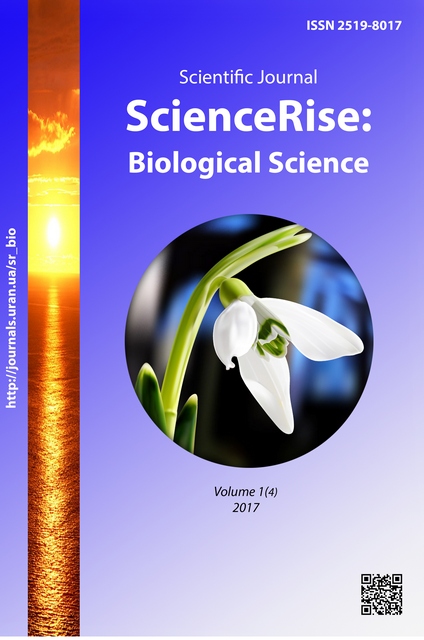Распределение вызванных потенциалов поперек дорсальной поверхности спинного мозга при транссекции дорсальных корешков
DOI:
https://doi.org/10.15587/2519-8025.2017.93617Ключові слова:
вызванные потенциалы, амплитуда, поперечное распределение, деафферентация, дорсальный корешок, спинной мозгАнотація
На кошках изучали распределение амплитуды вызванных потенциалов (ВП) поперек спинного мозга (СМ) при последовательной перерезке одного или нескольких соседних дорсальных корешков (ДК). Выявлено, что перерезки ДК приводят как к изменениям амплитуд компонетов ВП, так и смещению точки максимума потенциала с ипсилатеральной (относительно места стимуляции) – на контралатеральную сторону дорсальной поверхности СМ
Посилання
- Sabapathy, V., Tharion, G., Kumar, S. (2015). Cell Therapy Augments Functional Recovery Subsequent to Spinal Cord Injury under Experimental Conditions. Stem Cells International, 2015, 1–12. doi: 10.1155/2015/132172
- Qin, W., Bauman, W. A., Cardozo, C. (2010). Bone and muscle loss after spinal cord injury: organ interactions. Annals of the New York Academy of Sciences, 1211 (1), 66–84. doi: 10.1111/j.1749-6632.2010.05806.x
- Bazley, F. A., Hu, C., Maybhate, A., Pourmorteza, A., Pashai, N., Thakor, N. V. et. al. (2012). Electrophysiological evaluation of sensory and motor pathways after incomplete unilateral spinal cord contusion. Journal of Neurosurgery: Spine, 16 (4), 414–423. doi: 10.3171/2012.1.spine11684
- Regan, D., Regan, M. P. (2009). Evoked Potentials: Recording Methods. Encyclopedia of Neuroscience, 29–37. doi: 10.1016/b978-008045046-9.00317-x
- Shugurov, О. О. (2011). The evoked potentials of spinal cord under influence on him of mechanical stimulus. Visnyk of Dnipropetrovsk University. Biology. Medicine, 2, 125–129.
- Shugurov, О. А., Shugurov, O. O. (2006). Evoked potentials of spinal cord. Dnipropetrovsk: Sciense and Education, 319.
- Shugurov, O. O. (2016). The dorsal root damage identifications by the longitudal distribution of the evoked potentials of spinal cord. ScienceRise, 2 (1 (19)), 16–22. doi: 10.15587/2313-8416.2016.60275
- Quiroz-Gonzalez, S., Segura-Alegria, B., Guadarrama-Olmos, J. C., Jimenez-Estrada, I. (2014). Cord Dorsum Potentials Evoked by Electroacupuncture Applied to the Hind Limbs of Rats. Journal of Acupuncture and Meridian Studies, 7 (1), 25–32. doi: 10.1016/j.jams.2013.06.013
- Grunewald, B., Geis, C. (2014). Measuring spinal presynaptic inhibition in mice by dorsal root potential recording in vivo. Journal of Visualized Experiments, 85, e51473. doi: 10.3791/51473
- Carlton, S. M. (2014). Nociceptive primary afferents: they have a mind of their own. The Journal of Physiology, 592 (16), 3403–3411. doi: 10.1113/jphysiol.2013.269654
- Cote, M.-P., Detloff, M. R., Wade, R. E., Lemay, M. A., Houle, J. D. (2012). Plasticity in ascending long propriospinal and descending supraspinal pathways in chronic cervical spinal cord injured rats. Frontiers in Physiology, 3, 330. doi: 10.3389/fphys.2012.00330
- Wang, G., Scott, S. A. (2002). Development of “normal” dermatomes and somatotopic maps by “abnormal” populations of cutaneous neurons. Developmental Biology, 251 (2), 424–433. doi: 10.1006/dbio.2002.0824
- Laumonnerie, C., Tong, Y. G., Alstermark, H., Wilson, S. I. (2015). Commissural axonal corridors instruct neuronal migration in the mouse spinal cord. Nature Communications, 6, 7028. doi: 10.1038/ncomms8028
- Rudomin, P. (2009). In search of lost presynaptic inhibition. Experimental Brain Research, 196 (1), 139–151. doi: 10.1007/s00221-009-1758-9
##submission.downloads##
Опубліковано
Як цитувати
Номер
Розділ
Ліцензія
Авторське право (c) 2017 Олег Олегович Шугуров

Ця робота ліцензується відповідно до Creative Commons Attribution 4.0 International License.
Наше видання використовує положення про авторські права Creative Commons CC BY для журналів відкритого доступу.
Автори, які публікуються у цьому журналі, погоджуються з наступними умовами:
1. Автори залишають за собою право на авторство своєї роботи та передають журналу право першої публікації цієї роботи на умовах ліцензії Creative Commons CC BY, котра дозволяє іншим особам вільно розповсюджувати опубліковану роботу з обов'язковим посиланням на авторів оригінальної роботи та першу публікацію роботи у цьому журналі.
2. Автори мають право укладати самостійні додаткові угоди щодо неексклюзивного розповсюдження роботи у тому вигляді, в якому вона була опублікована цим журналом (наприклад, розміщувати роботу в електронному сховищі установи або публікувати у складі монографії), за умови збереження посилання на першу публікацію роботи у цьому журналі.










